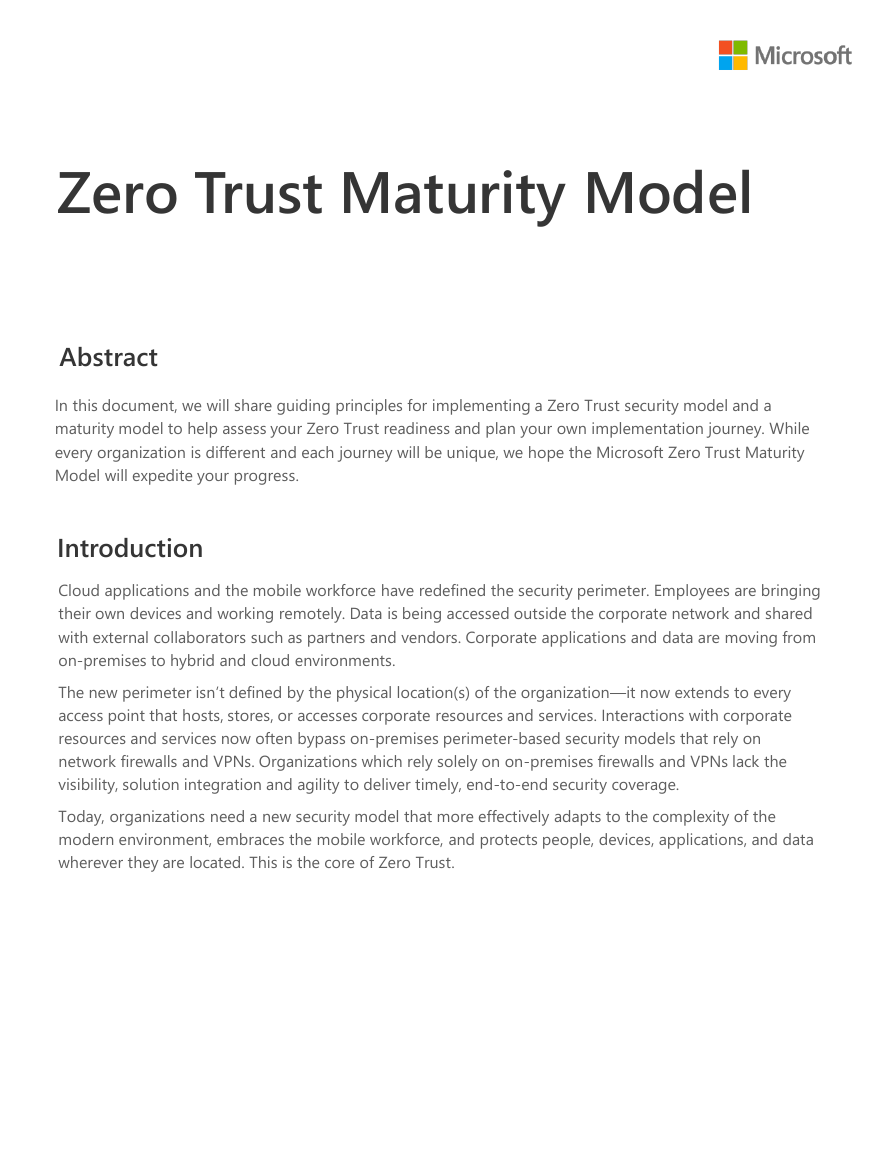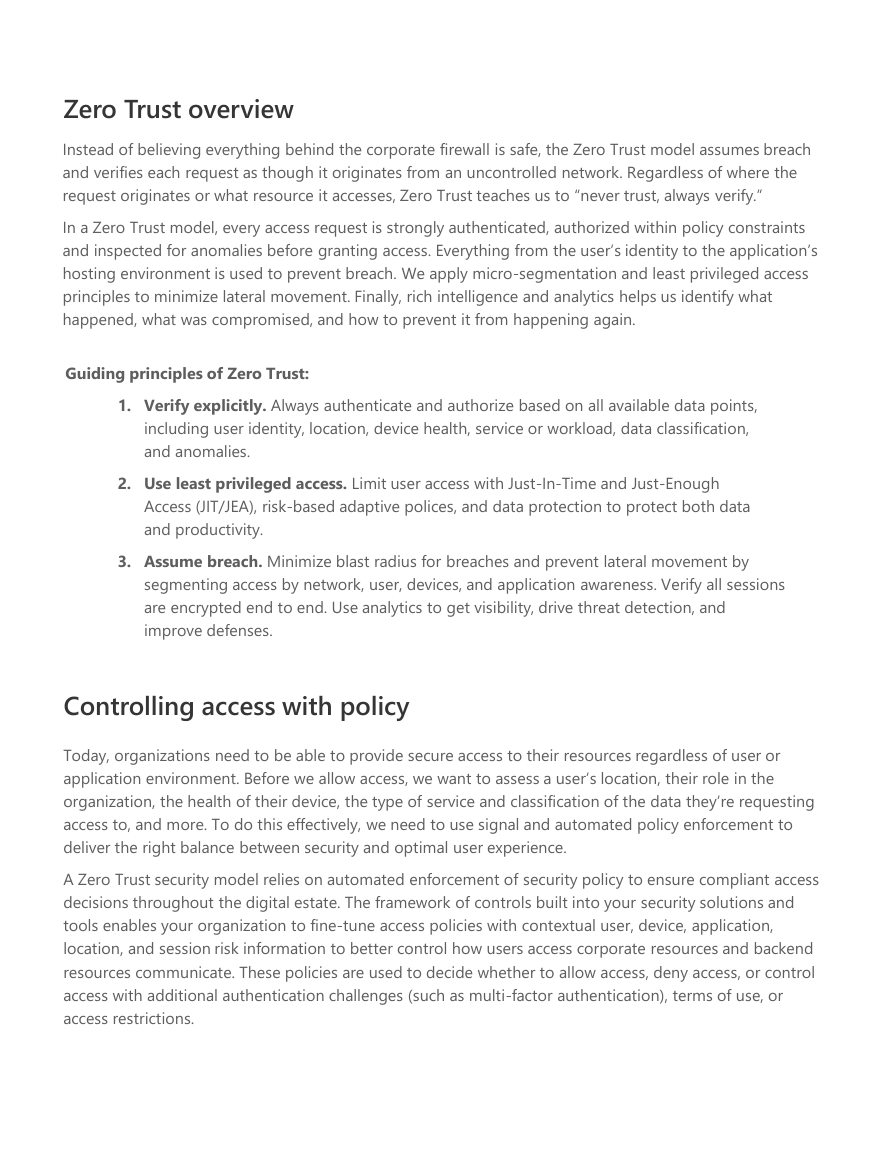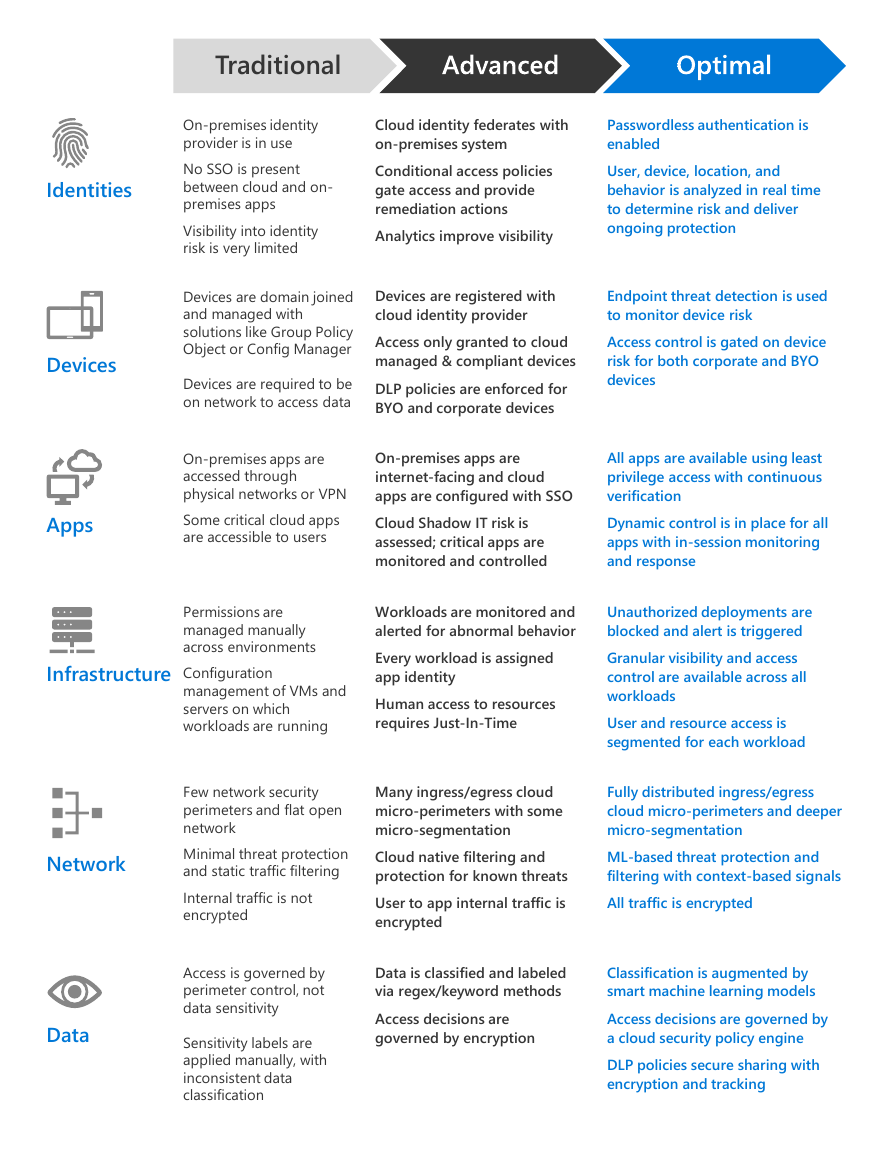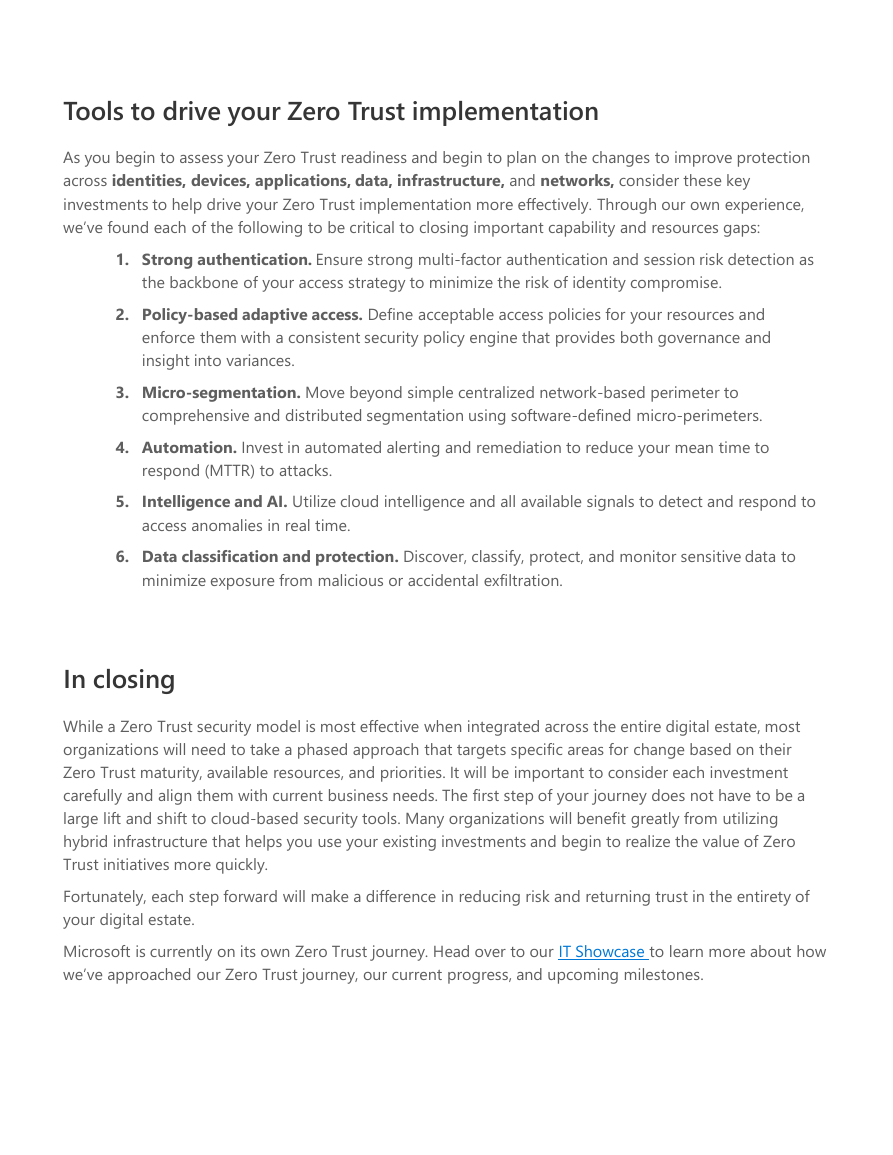Zero Trust Maturity Model
Abstract
In this document, we will share guiding principles for implementing a Zero Trust security model and a
maturity model to help assess your Zero Trust readiness and plan your own implementation journey. While
every organization is different and each journey will be unique, we hope the Microsoft Zero Trust Maturity
Model will expedite your progress.
Introduction
Cloud applications and the mobile workforce have redefined the security perimeter. Employees are bringing
their own devices and working remotely. Data is being accessed outside the corporate network and shared
with external collaborators such as partners and vendors. Corporate applications and data are moving from
on-premises to hybrid and cloud environments.
The new perimeter isn’t defined by the physical location(s) of the organization—it now extends to every
access point that hosts, stores, or accesses corporate resources and services. Interactions with corporate
resources and services now often bypass on-premises perimeter-based security models that rely on
network firewalls and VPNs. Organizations which rely solely on on-premises firewalls and VPNs lack the
visibility, solution integration and agility to deliver timely, end-to-end security coverage.
Today, organizations need a new security model that more effectively adapts to the complexity of the
modern environment, embraces the mobile workforce, and protects people, devices, applications, and data
wherever they are located. This is the core of Zero Trust.
�
Zero Trust overview
Instead of believing everything behind the corporate firewall is safe, the Zero Trust model assumes breach
and verifies each request as though it originates from an uncontrolled network. Regardless of where the
request originates or what resource it accesses, Zero Trust teaches us to “never trust, always verify.”
In a Zero Trust model, every access request is strongly authenticated, authorized within policy constraints
and inspected for anomalies before granting access. Everything from the user’s identity to the application’s
hosting environment is used to prevent breach. We apply micro-segmentation and least privileged access
principles to minimize lateral movement. Finally, rich intelligence and analytics helps us identify what
happened, what was compromised, and how to prevent it from happening again.
Guiding principles of Zero Trust:
1. Verify explicitly. Always authenticate and authorize based on all available data points,
including user identity, location, device health, service or workload, data classification,
and anomalies.
2. Use least privileged access. Limit user access with Just-In-Time and Just-Enough
Access (JIT/JEA), risk-based adaptive polices, and data protection to protect both data
and productivity.
3. Assume breach. Minimize blast radius for breaches and prevent lateral movement by
segmenting access by network, user, devices, and application awareness. Verify all sessions
are encrypted end to end. Use analytics to get visibility, drive threat detection, and
improve defenses.
Controlling access with policy
Today, organizations need to be able to provide secure access to their resources regardless of user or
application environment. Before we allow access, we want to assess a user’s location, their role in the
organization, the health of their device, the type of service and classification of the data they’re requesting
access to, and more. To do this effectively, we need to use signal and automated policy enforcement to
deliver the right balance between security and optimal user experience.
A Zero Trust security model relies on automated enforcement of security policy to ensure compliant access
decisions throughout the digital estate. The framework of controls built into your security solutions and
tools enables your organization to fine-tune access policies with contextual user, device, application,
location, and session risk information to better control how users access corporate resources and backend
resources communicate. These policies are used to decide whether to allow access, deny access, or control
access with additional authentication challenges (such as multi-factor authentication), terms of use, or
access restrictions.
�
Building Zero Trust into your organization
A Zero Trust approach should extend throughout the entire digital estate and serve as an integrated security
philosophy and end-to-end strategy. This is done by implementing Zero Trust controls and technologies
across six foundational elements: identities, devices, applications, data, infrastructure, and networks.
Each of these six foundational elements is a source of signal, a control plane for enforcement, and a critical
resource to be defended. This makes each an important area to focus investments.
Identities
Identities – whether they represent people, services, or IOT devices – define the Zero Trust control plane.
When an identity attempts to access a resource, we need to verify that identity with strong authentication,
ensure access is compliant and typical for that identity, and follows least privilege access principles.
Devices
Once an identity has been granted access to a resource, data can flow to a variety of different devices—from
IoT devices to smartphones, BYOD to partner managed devices, and on-premises workloads to cloud hosted
servers. This diversity creates a massive attack surface area, requiring we monitor and enforce device health
and compliance for secure access.
Applications
Applications and APIs provide the interface by which data is consumed. They may be legacy on-premises,
lift-and-shifted to cloud workloads, or modern SaaS applications. Controls and technologies should be
applied to discover Shadow IT, ensure appropriate in-app permissions, gate access based on real-time
analytics, monitor for abnormal behavior, control of user actions, and validate secure configuration options.
Data
Ultimately, security teams are focused on protecting data. Where possible, data should remain safe even if
it leaves the devices, apps, infrastructure, and networks the organization controls. Data should be classified,
labeled, and encrypted, and access restricted based on those attributes.
Infrastructure
Infrastructure (whether on-premises servers, cloud-based VMs, containers, or micro-services) represents a
critical threat vector. Assess for version, configuration, and JIT access to harden defense, use telemetry to
detect attacks and anomalies, and automatically block and flag risky behavior and take protective actions.
Networks
All data is ultimately accessed over network infrastructure. Networking controls can provide critical “in pipe”
controls to enhance visibility and help prevent attackers from moving laterally across the network.
Networks should be segmented (including deeper in-network micro segmentation) and real-time threat
protection, end-to-end encryption, monitoring, and analytics should be employed.
�
Zero Trust across the digital estate
In an optimal Zero Trust implementation, your digital estate is connected and able to provide the signal
needed to make informed access decisions using automated policy enforcement.
Let’s explore how the major components of the Zero Trust model all work together to deliver end-to-
end coverage.
Identities
Devices
Data
Classify,
label, encrypt
Emails & documents
Identity provider
Multi-factor
authentication
User/session risk
Device risk &
compliance state
Device identity
Security
Policy Enforcement
Adaptive
Access
Access &
runtime control
Threat
protection
Structured data
Apps
SaaS Apps
On-premises Apps
Infrastructure
S
a
a
I
S
a
a
P
s
e
t
i
S
.
t
n
I
i
s
r
e
n
a
t
n
o
C
s
s
e
l
r
e
v
r
e
S
JIT and Version Control
Network
Network delivery
Internal Micro-segmentation
Visibility and Analytics
Automation
Improving visibility and embracing security automation
Because Zero Trust relies heavily on signal and solution integration to be successful, this is a great time to
work towards providing greater visibility into your threat landscape and embracing security automation.
The Security Operations Center (SOC) should have a multi-tier incident response team in place that uses
advanced threat detection and AI-driven alert management capabilities to cut through the noise and
deliver prioritized security alerts. Response to common incidents, such as denying access to infected
devices, should be automated to improve response times and reduce risk exposure.
�
Not every Zero Trust model implementation is the same
Different organizational requirements, existing technology implementations, and security stages all affect
how a Zero Trust security model implementation is planned. Using our experience in helping customers to
secure their organizations as well as implementing our own Zero Trust model, we’ve developed the
following maturity model to help you assess your Zero Trust readiness and build a plan to get to Zero Trust.
Maturity
model
This is where most organizations
generally sit today if they haven’t
started their Zero Trust journey:
• On-premises identity with static
•
•
rules and some SSO.
Limited visibility is available into
device compliance, cloud
environments, and logins.
Flat network infrastructure results
in broad risk exposure.
TRADITIONAL
Organizations in the optimal stage have made large
improvements in security:
• Cloud identity with real-time analytics dynamically gate
access to applications, workloads, networks, and data.
• Data access decisions are governed by cloud security
policy engines and sharing is secured with encryption
and tracking.
• Trust has been removed from the network entirely—
micro cloud perimeters, micro- segmentation, and
encryption are in place.
• Automatic threat detection and response
is implemented.
OPTIMAL
ADVANCED
In this stage, organizations have begun their Zero
Trust journey and are making progress in a few key
areas:
• Hybrid identity and finely-tuned access policies are
gating access to data, apps, and networks.
• Devices are registered and compliant to IT security
policies.
• Networks are being segmented and cloud threat
protection is in place.
• Analytics are starting to be used to assess user
behavior and proactively identify threats.
On the next page you will find an expanded maturity model to help you assess your own Zero
Trust readiness across your user identities, devices, application, data, infrastructure, and networks.
�
Traditional
On-premises identity
provider is in use
Cloud identity federates with
on-premises system
Passwordless authentication is
enabled
Identities
Devices
No SSO is present
between cloud and on-
premises apps
Visibility into identity
risk is very limited
Devices are domain joined
and managed with
solutions like Group Policy
Object or Config Manager
Conditional access policies
gate access and provide
remediation actions
Analytics improve visibility
User, device, location, and
behavior is analyzed in real time
to determine risk and deliver
ongoing protection
Devices are registered with
cloud identity provider
Endpoint threat detection is used
to monitor device risk
Access only granted to cloud
managed & compliant devices
Access control is gated on device
risk for both corporate and BYO
devices
Devices are required to be
on network to access data
DLP policies are enforced for
BYO and corporate devices
On-premises apps are
accessed through
physical networks or VPN
On-premises apps are
internet-facing and cloud
apps are configured with SSO
All apps are available using least
privilege access with continuous
verification
Apps
Some critical cloud apps
are accessible to users
Cloud Shadow IT risk is
assessed; critical apps are
monitored and controlled
Dynamic control is in place for all
apps with in-session monitoring
and response
Infrastructure
Permissions are
managed manually
across environments
Configuration
management of VMs and
servers on which
workloads are running
Workloads are monitored and
alerted for abnormal behavior
Unauthorized deployments are
blocked and alert is triggered
Every workload is assigned
app identity
Human access to resources
requires Just-In-Time
Granular visibility and access
control are available across all
workloads
User and resource access is
segmented for each workload
Few network security
perimeters and flat open
network
Many ingress/egress cloud
micro-perimeters with some
micro-segmentation
Fully distributed ingress/egress
cloud micro-perimeters and deeper
micro-segmentation
Network
Minimal threat protection
and static traffic filtering
Cloud native filtering and
protection for known threats
ML-based threat protection and
filtering with context-based signals
Internal traffic is not
encrypted
User to app internal traffic is
encrypted
All traffic is encrypted
Data
Access is governed by
perimeter control, not
data sensitivity
Sensitivity labels are
applied manually, with
inconsistent data
classification
Data is classified and labeled
via regex/keyword methods
Classification is augmented by
smart machine learning models
Access decisions are
governed by encryption
Access decisions are governed by
a cloud security policy engine
DLP policies secure sharing with
encryption and tracking
�
Tools to drive your Zero Trust implementation
As you begin to assess your Zero Trust readiness and begin to plan on the changes to improve protection
across identities, devices, applications, data, infrastructure, and networks, consider these key
investments to help drive your Zero Trust implementation more effectively. Through our own experience,
we’ve found each of the following to be critical to closing important capability and resources gaps:
1. Strong authentication. Ensure strong multi-factor authentication and session risk detection as
the backbone of your access strategy to minimize the risk of identity compromise.
2. Policy-based adaptive access. Define acceptable access policies for your resources and
enforce them with a consistent security policy engine that provides both governance and
insight into variances.
3. Micro-segmentation. Move beyond simple centralized network-based perimeter to
comprehensive and distributed segmentation using software-defined micro-perimeters.
4. Automation. Invest in automated alerting and remediation to reduce your mean time to
respond (MTTR) to attacks.
5.
Intelligence and AI. Utilize cloud intelligence and all available signals to detect and respond to
access anomalies in real time.
6. Data classification and protection. Discover, classify, protect, and monitor sensitive data to
minimize exposure from malicious or accidental exfiltration.
In closing
While a Zero Trust security model is most effective when integrated across the entire digital estate, most
organizations will need to take a phased approach that targets specific areas for change based on their
Zero Trust maturity, available resources, and priorities. It will be important to consider each investment
carefully and align them with current business needs. The first step of your journey does not have to be a
large lift and shift to cloud-based security tools. Many organizations will benefit greatly from utilizing
hybrid infrastructure that helps you use your existing investments and begin to realize the value of Zero
Trust initiatives more quickly.
Fortunately, each step forward will make a difference in reducing risk and returning trust in the entirety of
your digital estate.
Microsoft is currently on its own Zero Trust journey. Head over to our IT Showcase to learn more about how
we’ve approached our Zero Trust journey, our current progress, and upcoming milestones.
�














 2023年江西萍乡中考道德与法治真题及答案.doc
2023年江西萍乡中考道德与法治真题及答案.doc 2012年重庆南川中考生物真题及答案.doc
2012年重庆南川中考生物真题及答案.doc 2013年江西师范大学地理学综合及文艺理论基础考研真题.doc
2013年江西师范大学地理学综合及文艺理论基础考研真题.doc 2020年四川甘孜小升初语文真题及答案I卷.doc
2020年四川甘孜小升初语文真题及答案I卷.doc 2020年注册岩土工程师专业基础考试真题及答案.doc
2020年注册岩土工程师专业基础考试真题及答案.doc 2023-2024学年福建省厦门市九年级上学期数学月考试题及答案.doc
2023-2024学年福建省厦门市九年级上学期数学月考试题及答案.doc 2021-2022学年辽宁省沈阳市大东区九年级上学期语文期末试题及答案.doc
2021-2022学年辽宁省沈阳市大东区九年级上学期语文期末试题及答案.doc 2022-2023学年北京东城区初三第一学期物理期末试卷及答案.doc
2022-2023学年北京东城区初三第一学期物理期末试卷及答案.doc 2018上半年江西教师资格初中地理学科知识与教学能力真题及答案.doc
2018上半年江西教师资格初中地理学科知识与教学能力真题及答案.doc 2012年河北国家公务员申论考试真题及答案-省级.doc
2012年河北国家公务员申论考试真题及答案-省级.doc 2020-2021学年江苏省扬州市江都区邵樊片九年级上学期数学第一次质量检测试题及答案.doc
2020-2021学年江苏省扬州市江都区邵樊片九年级上学期数学第一次质量检测试题及答案.doc 2022下半年黑龙江教师资格证中学综合素质真题及答案.doc
2022下半年黑龙江教师资格证中学综合素质真题及答案.doc